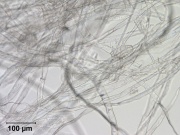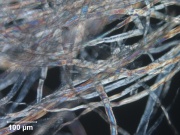Difference between revisions of "Chemical wood pulp"
Jump to navigation
Jump to search
(username removed) |
(username removed) |
||
| Line 4: | Line 4: | ||
Paper pulp made from chemically treated wood fibers. Chemical pulp is produced by treating debarked, ground wood with strong solutions to dissolve the lignin. The undissolved cellulose fibers are washed, rinsed, sometimes bleached, then used to produce paper. The three main types of solutions used to make chemical pulp are: | Paper pulp made from chemically treated wood fibers. Chemical pulp is produced by treating debarked, ground wood with strong solutions to dissolve the lignin. The undissolved cellulose fibers are washed, rinsed, sometimes bleached, then used to produce paper. The three main types of solutions used to make chemical pulp are: | ||
| − | - alkaline: [http://cameo.mfa.org/materials/fullrecord.asp?name=sodium | + | - alkaline: [http://cameo.mfa.org/materials/fullrecord.asp?name=sodium%20sulfide sodium sulfide] followed by [http://cameo.mfa.org/materials/fullrecord.asp?name=sodium%20hydroxide caustic soda] solution (kraft process), |
- alkaline: caustic soda (soda process), | - alkaline: caustic soda (soda process), | ||
| − | - acid: [http://cameo.mfa.org/materials/fullrecord.asp?name=calcium | + | - acid: [http://cameo.mfa.org/materials/fullrecord.asp?name=calcium%20bisulfite acid bisulfite] (sulfite process). |
[[File:100_Chem. softwood_conif_pol adj.jpg|thumb|Chemical hardwood (non-coniferous)]] | [[File:100_Chem. softwood_conif_pol adj.jpg|thumb|Chemical hardwood (non-coniferous)]] | ||
| Line 29: | Line 29: | ||
== Authority == | == Authority == | ||
| − | * ''Encyclopedia Britannica'', http://www.britannica.com Comment: "Paper Pulp." | + | * ''Encyclopedia Britannica'', http://www.britannica.com Comment: "Paper Pulp." Encyclopædia Britannica. 2003. 11 Sep, 2003 . |
| − | * | + | * Random House, ''Webster's Encyclopedic Unabridged Dictionary of the English Language'', Grammercy Book, New York, 1997 |
| − | * | + | * G.S.Brady, ''Materials Handbook'', McGraw-Hill Book Co., New York, 1971 Comment: p. 574 |
* ''The Dictionary of Paper'', American Paper Institute, New York, Fourth Edition, 1980 | * ''The Dictionary of Paper'', American Paper Institute, New York, Fourth Edition, 1980 | ||
| − | * | + | * E.J.LaBarre, ''Dictionary and Encyclopedia of Paper and Paper-making'', Swets & Zeitlinger, Amsterdam, 1969 |
| − | * | + | * Boise Cascade Paper Group, ''The Paper Handbook'', Boise Cascade, Portland OR, 1989 |
| − | * | + | * Matt Roberts, Don Etherington, ''Bookbinding and the Conservation of Books: a Dictionary of Descriptive Terminology'', U.S. Government Printing Office, Washington DC, 1982 |
| − | * | + | * Silvie Turner, ''Which Paper?'', Design Press, New York, 1991 |
[[Category:Materials database]] | [[Category:Materials database]] | ||
Revision as of 07:29, 24 July 2013
Description
Paper pulp made from chemically treated wood fibers. Chemical pulp is produced by treating debarked, ground wood with strong solutions to dissolve the lignin. The undissolved cellulose fibers are washed, rinsed, sometimes bleached, then used to produce paper. The three main types of solutions used to make chemical pulp are:
- alkaline: sodium sulfide followed by caustic soda solution (kraft process),
- alkaline: caustic soda (soda process),
- acid: acid bisulfite (sulfite process).
Synonyms and Related Terms
chemical pulp; woodfree pulp
Other Properties
Produces a pale blue-violet to red violet response to iodine-zinc chloride solution.
Additional Images
Authority
- Encyclopedia Britannica, http://www.britannica.com Comment: "Paper Pulp." Encyclopædia Britannica. 2003. 11 Sep, 2003 .
- Random House, Webster's Encyclopedic Unabridged Dictionary of the English Language, Grammercy Book, New York, 1997
- G.S.Brady, Materials Handbook, McGraw-Hill Book Co., New York, 1971 Comment: p. 574
- The Dictionary of Paper, American Paper Institute, New York, Fourth Edition, 1980
- E.J.LaBarre, Dictionary and Encyclopedia of Paper and Paper-making, Swets & Zeitlinger, Amsterdam, 1969
- Boise Cascade Paper Group, The Paper Handbook, Boise Cascade, Portland OR, 1989
- Matt Roberts, Don Etherington, Bookbinding and the Conservation of Books: a Dictionary of Descriptive Terminology, U.S. Government Printing Office, Washington DC, 1982
- Silvie Turner, Which Paper?, Design Press, New York, 1991



